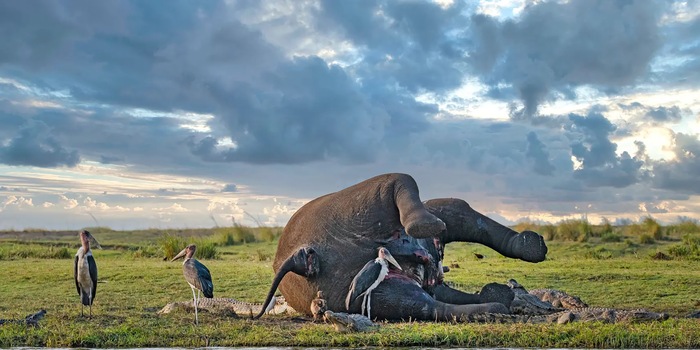
Are bacteria to blame for sudden elephant deaths?
In 2020, hundreds of elephants died in rapid succession in southern Africa. The cause could now be found: dangerous germs in the blood of the pachyderms.
In 2020 and 2021 several hundred elephants died in Zimbabwe and Botswana. Some of the victims appeared to have collapsed while walking, and none showed obvious wounds from predators or poachers. A team led by Chris Foggin from the Victoria Falls Wildlife Trust in Zimbabwe may have uncovered the cause of the pachyderms' deaths, as they report in "Nature Communications": In samples from the carcasses, they detected a bacterium closely related to Pasteurella multocida, which can cause fatal blood poisoning - a germ that has never before been detected in elephants.
In 2020, Foggin and co took tissue samples from more than a dozen dead elephants that had died in north-west Zimbabwe - a difficult endeavour as they had to get to the organs of the huge animals. At least 13 of the 15 pachyderms examined showed signs of septicaemia. The biologists discovered the bacterium, previously known as Bisgaard taxon 45, in the tissue of six individuals. This bacterium had previously been detected in samples of tiger and lion bite marks.
Until now, the pathogen had not been associated with septicaemia, but as it is closely related to a known trigger of septicaemia, a connection is obvious. It may have developed its deadly effect because the elephant herds were under considerable environmental stress in 2020 and 2021: A severe drought caused food and water shortages. The animals had to compete for the available resources and were malnourished or dehydrated. Their weakened immune system was unable to keep the bacteria sufficiently in check.
It is unclear whether the bacteria are part of the pachyderms' microbiome in principle or how they were transferred to the elephants. Lions only hunt the animals in exceptional cases and only very rarely prey on them, such as young animals. However, they could have transmitted the bacteria via bites during experiments. The elephants may have become infected via the water, as many other species also had to find their way to the remaining waterholes and contaminated them with saliva or faeces.
The elephants could then have infected each other, as the animals maintain close contact. Due to poaching and hunting for ivory, the number of elephants has fallen sharply again in recent years. Added to this are the consequences of climate change, which means that extreme weather events are occurring more frequently. Biologists are therefore concerned that increased stress makes elephants more susceptible to disease, which further threatens their survival. Another study in 2020 came to the conclusion that some of the animals may have been poisoned by the water: Cyanobacteria had multiplied in the water holes and excreted toxins.
Spectrum of science
We are a partner of Spektrum der Wissenschaft and want to make sound information more accessible to you. Follow Spektrum der Wissenschaft if you like the articles.
[[small:]]
© guenterguni / Getty Images / iStock (detail) An elephant carcass lies on the riverbank in Botswana's Chobe National Park - to the delight of numerous scavengers.
Experts from science and research report on the latest findings in their fields – competent, authentic and comprehensible.